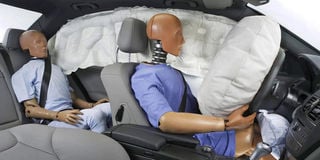Prime
Ask the Mechanic: Why would airbags refuse to work?

Recently, my cousin was involved in an accident and rolled his car. However, the airbags did not deploy. What could have happened? Tony
Hello Tony, airbags are self-inflatable cushions that are strategically positioned to protect car occupants during a collision or rollover accidents. Occasionally, car airbags may fail to deploy and protect the passengers.
To understand why, let us first appreciate how they work. Airbags are part of a modern car’s supplementary restraint system (SRS) designed to boost the safety provided by the seatbelts. They work with other components of the SRS system such as airbag control modules, circuits, crash sensors as well as seatbelt pretensioning components to ensure that you are safe during frontal or side impacts as well as rollover accidents.
When crash sensors detect an impact, they send a signal to the control module via the different circuits, which in turn ignites the inflating device to quickly fill up the deployed airbag to cushion the passenger. There are a few reasons why airbags will not deploy during a collision or accident and one of them is the design of a particular car.
Older cars are designed without airbags or only have a driver steering fitted airbag. Newer cars come with multiple airbags that protect the driver, co-driver and rear passengers. Other cars have up to eight or 11 airbags and crash sensors to protect the car occupants from frontal and side collision as well as accidents. It is important to know if the car in question had the side impact airbags that deploy during an accident.
Secondly, it is important to keep the SRS or airbag system free of faults and in working condition. One should not ignore the SRS fault light on the dashboard, which might be warning you about a faulty circuit, crash sensor or module in the SRS system. If any of these components fail, the airbags may not deploy.
Also, when airbags deploy after an accident, they should be replaced with new ones, their circuits inspected and crash sensors replaced as they tend to be single use devices. Any attempt to reuse an airbag and crash sensor after an accident will lead to failed deployment when needed.
It is also important to note that the SRS airbags work well when you are safely harnessed behind a seatbelt.
What causes tyres to wear out on one side?
My tyres are wearing down on one side more than the other. What could be the cause? Veronica Mukasa
Hello Veronica, uneven tyre wear is usually caused by wrong wheel alignment. Tyre wear on the inner side is called ‘toe wear’ while that on the outer side is called ‘camber’ wear. Driving a car with worn out tyres affects driveability at high speed.
You can resolve this by visiting a tyre dealer to carry out wheel alignment. If tyres are excessively worn out, you may have to replace them. There are other common patterns of tyre wear and their unique causes. Tyre wear on the inner or outer edges is usually caused by under inflation. Diagonal wear of the tyres is usually caused by worn out suspension.
Are used tyres really cost-friendly?
I am in the market for new tyres and I have noticed that used tyres are cheaper than new ones. Will they really save me money? Agnes
Hello Agnes, used tyres are arguably money savers because they usually cost less than half the price of new ones. However, they have a fraction of the life of a new tyre so what you pay for may be what you get. Even worse, used tyres may compromise your road safety. This can potentially cost you the car or used tyres may come with a poor maintenance history such as bad wheel alignment, which may have caused uneven wear or damage. This will cause wobbling or premature failure. Poorly stored or expired (after five years) used tyres tend to have weakened tyre walls while wrong season (for example winter) used tyres will have tyre compounds suitable for cold weather use.
In this case, on hot days, the above tyres are likely to burst or tear at high speeds or on the highway. The sudden loss of tyre pressure and traction could cause a costly accident.
Determining space for a spare tyre
How do I work out what space saver size I need for a spare wheel? Peter Muturi
Hello Peter, the quickest way to know whether a space saver wheel will fit on your car is by establishing the pattern of lugs (studs) which attach to the wheel hub and their distance apart. If it is the same as that of your current car wheels, then it should work for you.You ought to establish that the space saver rolling radius is the same as that of your car’s full size tyres.
For the benefit of other readers, space saver tyres (also called donuts) are emergency tyres used temporarily in the event that you get a punctured tyre. They are smaller than the full size tyre (diameter and width), usually have a bright yellow rim and can be stowed away conveniently in your car boot.
They should not be used as permanent replacements. Also, one should drive drive at moderate speeds when using a space saver tyre as it alters handling and manoeuvrability.




